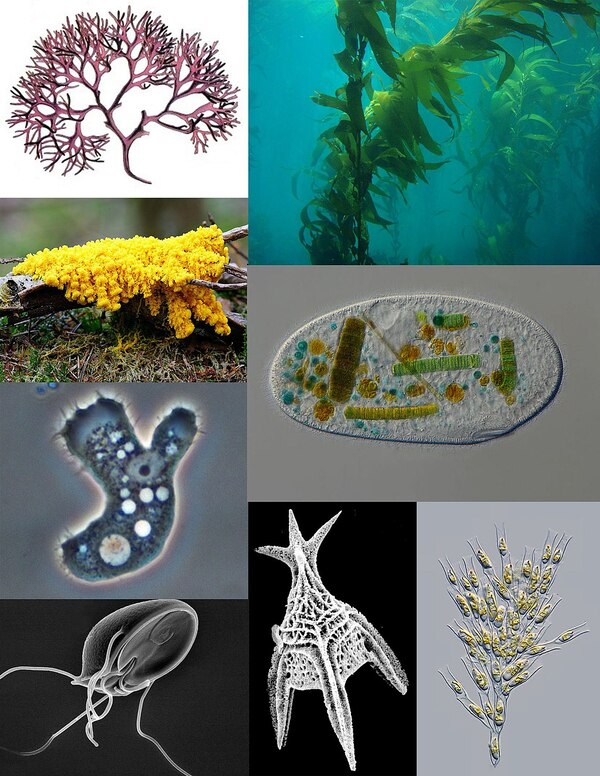Protists and animals are both fascinating groups of eukaryotic organisms, but they differ significantly in their structure, behavior, and roles in the ecosystem. Understanding these differences provides insight into the complexity and diversity of life. Below, we explore the major distinctions between protists and animals, diving deep into their characteristics, ecological roles, and evolutionary history.

Protists belong to the Kingdom Protista, which is considered a catch-all category for eukaryotic organisms that don’t fit into the other kingdoms.
Unicellular Nature: Most protists are unicellular, though some, like algae, can form colonies or exhibit multicellular structures.
Eukaryotic Structure: Protists have a true nucleus enclosed in a membrane and organelles like mitochondria and chloroplasts (in photosynthetic protists).
Nutritional Diversity: Protists can be autotrophic (photosynthetic, like algae) or heterotrophic (consuming organic material, like amoebas).
Motility: Many protists move using structures like flagella, cilia, or pseudopodia, such as the amoeba's flexible cell extensions.
Habitat: Protists thrive in aquatic environments, from freshwater ponds to saltwater oceans, and are also found in moist soils.
Examples of Protists: Amoeba, Paramecium, Euglena, Plasmodium (malaria-causing parasite).

Animals, classified under Kingdom Animalia, are multicellular organisms with specialized tissues and complex body systems.
Multicellular Structure: Animals are composed of multiple cells that differentiate into tissues and organs.
Eukaryotic Nature: Like protists, animals are eukaryotic but exhibit greater structural and functional complexity.
Heterotrophic Nutrition: Animals exclusively rely on consuming other organisms for energy.
Motility: Most animals are highly mobile, using limbs, fins, or wings for locomotion.
Nervous Systems: Animals possess nervous systems to process sensory information and coordinate responses.
Examples of Animals: Humans, lions, fish, insects, reptiles, and birds.
| Feature | Protists | Animals |
|---|---|---|
| Cellularity | Mostly unicellular | Exclusively multicellular |
| Nutrition | Autotrophic or heterotrophic | Heterotrophic |
| Nervous System | Absent | Present in varying complexity |
| Movement | Cilia, flagella, or pseudopodia | Limbs, fins, wings, or entire body |
| Reproduction | Asexual (binary fission) or sexual | Predominantly sexual reproduction |
| Habitat | Aquatic or moist environments | Diverse: land, sea, air |
Protists and animals both play critical roles in ecosystems, though their contributions differ.
Primary Producers: Photosynthetic protists like phytoplankton are foundational to aquatic food chains.
Decomposers: Certain protists break down organic material, recycling nutrients in the ecosystem.
Parasites: Some, like Plasmodium, cause diseases such as malaria in animals and humans.
Consumers: Animals are primary, secondary, or tertiary consumers in the food web.
Pollinators: Insects like bees facilitate plant reproduction.
Predators and Prey: Animals maintain balance by regulating population dynamics in ecosystems.
Protists are believed to be the ancestors of all multicellular life, including animals. Over time, single-celled eukaryotic organisms evolved into complex multicellular forms, leading to the development of specialized tissues and organs found in animals.
Protists’ Evolutionary Role: Early protists like choanoflagellates share similarities with the first multicellular animals, the sponges.
Genetic Complexity: Animals evolved greater genetic regulation and specialization compared to protists.
Many protists reproduce asexually through binary fission, allowing rapid population growth.
Some can also reproduce sexually, increasing genetic diversity.
Sexual reproduction dominates in animals, ensuring genetic variation and adaptability.
A few species, like certain lizards, can reproduce asexually through parthenogenesis.
Protists often possess metabolic flexibility, capable of photosynthesis (Euglena) or heterotrophy (Amoeba). In contrast, animals rely solely on consuming organic matter, requiring digestive systems to break down food.
Photosynthesis in Protists: Algae convert sunlight into energy, serving as oxygen producers in aquatic environments.
Cellular Respiration in Animals: Animals depend on cellular respiration to extract energy from consumed food.
Unlike animals, some protists can directly harm other organisms.
Plasmodium: Causes malaria, impacting millions annually.
Giardia: A parasite causing digestive issues in humans.
In contrast, animals rarely serve as direct agents of diseases, acting more often as vectors for pathogens.
Protists and animals, while both eukaryotic, occupy distinct places in the tree of life. Protists represent the bridge between simple unicellular life and the complex multicellular organisms we see today. Their unique characteristics and evolutionary significance make them essential to understanding life’s diversity. Animals, with their intricate body systems and ecological roles, showcase the pinnacle of multicellular complexity. Together, they highlight the extraordinary adaptability and variety of life on Earth.
By examining their differences, we gain deeper insights into the natural world and the evolutionary connections that bind all living organisms.
We created this article in conjunction with AI technology, then made sure it was fact-checked and edited by a Animals Top editor.